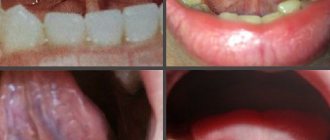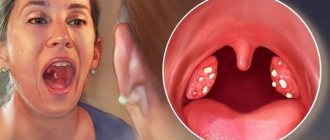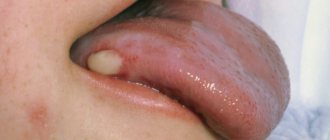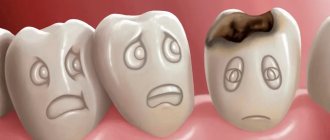The unconscious state always contains a certain danger. A person who has lost consciousness does not feel anything, his pain threshold is lowered, he does not understand what is happening to him, and is not able to help himself. Therefore, the victim needs medical attention.
An unconscious state is characterized by a serious threat of choking on vomit, blood, mucus and other masses that rush out of the digestive tract, simultaneously clogging the airways. However, more often in practice, another problem is observed, which is considered more dangerous than the movement of vomit, this is the displacement of the root of the tongue.
What it is?
Relaxation of the muscles of the lower jaw and the root muscles of the tongue while a person is unconscious will inevitably lead to the movement of the tongue from its usual position to the larynx. This phenomenon is popularly and medically called “tongue retraction.” It is characterized by a displacement of the tongue muscles towards the wall of the larynx, which leads to a cessation of air flow into the lungs, resulting in suffocation, in other words, asphyxia.
Retraction of the root of the tongue is primarily dangerous because, if the necessary assistance is not provided, the person will suffocate due to lack of air. Asphyxia that develops as a result of tongue displacement leads to a decrease in the level of oxygen in the tissues and an increase in the level of carbon dioxide in the blood. As a result, a person dies within 10 minutes from suffocation.
First aid for head injuries
Research shows that about 50% of people have had a head injury during a seizure. If there is a suspicion of a traumatic brain injury and the person is unconscious, it is necessary:
- carefully move the person to a safe place
- make sure your airways are clear
- listen to your breathing
- call an ambulance
- call the police if there is a security threat
- Apply a sterile bandage to open wounds
- cover him with a warm blanket or coat
- stay with him until the ambulance arrives
If the person is conscious, help him move to a position that he finds most comfortable. It is important to constantly check that the person is conscious and breathing normally until the ambulance arrives, and not to leave him unattended.
Causes of tongue retraction
The main reason for the development of this pathological condition is relaxation of the root of the tongue and the muscles of the lower jaw, which partly control the position of the tongue in the oral cavity. So, for example, if a victim has a broken lower jaw on both sides, then the likelihood of the tongue root being displaced is quite high.
However, in medical practice, such a cause of tongue displacement as a broken jaw is rare. Much more often, this phenomenon occurs during a long coma, during which many muscles, including the tongue, atrophy. A patient's tongue may become retracted after anesthesia is administered before surgery. Pathology is also observed in victims of accidents and other accidents, which entail severe pain shock.
Epilepsy as one of the reasons
There are still many myths about tongue swallowing during an epileptic seizure. Some people ignorant of medicine try to open the mouth of an epileptic during a seizure with a spoon, pens, or their own fingers, simultaneously fixing the unclenched jaws with a stick or other objects. It should be noted here that such measures not only will not help the patient, but can also break his teeth and damage the oral mucosa.
The only thing a passerby can do to help a person suffering from an epileptic seizure is to try to make the space around him as safe as possible: remove hot and sharp objects to prevent head injury, put soft clothes underneath. During an attack, a person may bite his tongue, but he will never swallow it for another reason: during an epileptic seizure, all the muscles of the body are extremely tense and hypertonic.
However, tongue retraction can actually happen, not during an attack, but after it, when the muscles, on the contrary, are in a state of hypotonicity. In this case, relaxation of the root of the tongue can cause it to move from its usual position and subsequent blockage of the larynx.
3 more exercises
- The “Pressing” exercise can strengthen the muscular corset of the tongue. You need to forcefully press it to the sky. Next, you should stay in this position for 10-15 seconds. Then, again with effort, pull your tongue towards the larynx. And again remain in the accepted position for 10 seconds. Next, press firmly with your tongue on the dental crowns of the upper row. Stay in this position for 10-12 seconds. There should be 3 approaches. Breathe through your nose and close your lips tightly.
- An equally productive exercise is “Show off your tongue.” We need to show it as much as possible. Try to reach it first to the edge of your nose, and then to your chin. There must be at least 20 approaches.
- The “Tongue Candle” exercise will also help. It is done very simply. You should open your mouth, just forcefully, to feel a slight stretch. Now try to reach the upper palate with your tongue. In this position, the hyoid part is quite tense. There are 10 approaches as usual. It is more productive to perform this task with your head tilted up.
Appearance of pathology
As mentioned, the main symptom and at the same time the most negative consequence of tongue displacement is choking. A person cannot breathe in air because the path to the lungs is blocked. He also cannot exhale air filled with carbon dioxide, as a result of which blood circulation in the body is disrupted. This leads to a change in the patient’s complexion; it acquires a bluish tint. The longer a person does not receive the required amount of oxygen, the further the so-called cyanosis spreads: the upper part of the chest becomes blue.
A person who has had a recessed tongue begins to sweat profusely, and the veins in his neck swell and increase in size. He begins to make reflexive involuntary movements with his arms and legs, rushing from side to side due to the inability to take a full breath. The breathing itself is hoarse, arrhythmic (due to excessive tension of the intercostal muscles and neck muscles).
How can I help?
First of all, the person whose tongue has shifted needs to be placed in a horizontal position. After performing this manipulation, it is necessary to tilt his head back: the left hand is placed on the victim’s forehead, and the right hand at this time raises the neck, and a retainer (pillow, bolster) is placed under it. After throwing back the head, you need to extend his lower jaw. To do this, its right and left corners are taken with both hands, shifted down and then raised forward. If breathing is restored, the person should be turned on his side to prevent relapse.
If these measures do not help to restore the patency of the airways when the tongue is retracted, then you need to move on to a proven and guaranteed method of ending the state of suffocation by getting rid of the causative factor. In this case, this is removing the tongue from the oral cavity and fixing it outside. Manipulation involves pulling the tongue out of the mouth using cloth-wrapped fingers, tweezers, forceps and, in fact, any instrument capable of capturing and holding the tongue. The next step is to secure it at the chin with an adhesive plaster or bandage.
If the displacement of the root of the tongue occurs due to a fracture of the lower jaw, then assistance should immediately begin with removing it from the mouth and subsequent fixation at the chin. Subsequent manipulations, such as matching and connecting fragments of a broken jaw, can only be provided in a specialized institution. Also, in ambulances called, doctors can provide professional assistance with tongue retraction, as they have devices for artificial ventilation of the lungs. A special air duct is placed between the root of the tongue and the wall of the pharynx, providing the lungs with air flow.
First aid for seizures
Before a seizure
If a person is showing signs of a seizure, the following steps can be taken:
- carefully take him to a safe place
- if a person is indoors, remove all furniture and other objects that are near him, paying special attention to creating space around his head
- make sure that electrical equipment or kitchen appliances are not turned on and could not cause harm
- gently lower the person to the floor if they are not already on the ground
- start timing the seizure from the moment it starts
During a seizure
If a person has already had a seizure, they should:
- carefully lower it to the ground
- take off his glasses if he wears them
- remove or loosen tight clothing, especially items around the neck or head
- place something under your head, such as a folded sweater, or use your arms to restrain your head to prevent head injury
- cover with a blanket or jacket
- Stay with the person during the seizure, talking to them in a calm, soothing manner until they come to their senses.
Do not try to restrain the person, perform artificial respiration, or offer anything to eat or drink during a seizure. If the attack lasts more than 5 minutes, seek medical help.
After a seizure
If the person is unconscious:
- Turn your head to the side to keep your airway open.
- Check your breathing.
- Until he comes to, keep him covered with a blanket and check his reaction every few minutes.
If a person comes to his senses:
- Remember that the person will likely feel tired and disoriented.
- Ask the person his name and where he is.
- Calm the person down and explain that they were having a seizure.
- Stay with them until he finally comes to his senses and help him sit in a safe, comfortable place.
- Check for any injuries that the person may have sustained during the seizure and provide first aid.
- Make sure there is someone to walk him home or take a taxi.
What not to do
All manipulations regarding moving the victim in space and changing the position of his head and neck are contraindicated if the person is suspected of having a cervical fracture. Any careless movement towards the victim can harm him even more. In this case, changing the position of the jaw forward and down will suffice.
It is also worth noting that some citizens have a myth firmly entrenched in their heads that it is necessary to remove the tongue and pin it with a pin or needle to the victim’s collar or cheek. Doing this is absolutely contraindicated and pointless. Moreover, first aid for tongue retraction should not be provided by such barbaric methods. To fix the tongue, a regular adhesive plaster attached to the chin will do. Moreover, fixation itself is necessary in extreme cases; changing the position of the head and neck is usually enough.
Basic set of exercises for the tongue
- Pull your tongue down and forward to its maximum length. If you feel tension in the muscle fibers in the root area, then the movement is done correctly. Stay in this position for a couple of seconds. At the same time, you can pronounce drawn out, as if in a chant, “and-and-and.” At least 30 approaches. This will make the muscle fibers stronger.
- Using your tongue, press on the palate until you feel slightly tired.
- If you stretch your tongue far forward and move it vigorously to the sides, then over time the muscle corset will become toned, and snoring will disappear from the patient.
- Close your mouth tightly and inhale and exhale through your nose. At this time, tighten your tongue and point it towards your throat. The approximate number of approaches is 15. Regular exercise will definitely give a long lasting effect.
- Tilt your head up a little and try to touch the uvula with your tongue.
Prevention of tongue root displacement
When a person loses consciousness, the muscles of his body relax, including the tongue, which can fall to the back of the larynx, causing an attack of suffocation. This does not happen so often with ordinary fainting, but a number of measures should still be taken, the purpose of which is to prevent tongue retraction. Its main principle is to tilt the victim’s head back by raising the neck and placing a cushion under it. You can also secure the tongue with an adhesive tape or bandage passing through the bottom of the lower jaw and securing it around the forehead. If the jaw is broken, then you need to act differently: you need to put the person on his stomach, face down.
Oral injuries
Another potential complication of a seizure is oral trauma. In a 2021 survey, 106 people with epilepsy completed a questionnaire about the frequency of oral injury during seizures. The researchers found that:
- 52.4% of participants had oral injuries during seizures, most commonly affecting the lips, tongue, or cheeks
- 18% had cracked teeth
- 17% had tooth fractures
Tongue bite is a common injury associated with seizures. Do not place any object or fingers into a person's mouth during an attack. This may cause:
- jaw fracture
- broken teeth
- suffocation
Conclusion
Tongue retraction is a rather dangerous phenomenon, which consists in displacement of its root and clogging of the airways. A similar condition occurs when the muscles of the body, including the tongue, relax during unconsciousness, coma and anesthesia, as well as during fractures of the lower jaw.
When the tongue moves, the person begins to choke, the veins in his neck swell, his breathing becomes hoarse, and his face gradually turns blue. You can help a person by tilting his head back and changing the position of his jaw. It also helps to fix the tongue outside the mouth by attaching it to the chin, but in no case with pins or needles.
When to ask for help
You should call the emergency room if:
- this is the first seizure
- seizure in water
- labored breathing
- a second seizure that begins after the first seizure
- Seizures resulted in head injury
- seizure during pregnancy
- a seizure in a person with a serious medical condition such as heart disease or diabetes
If a person has epilepsy and has already had a seizure, they may want to see a doctor. A person does not need emergency help unless there was a serious injury or the attack did not last more than 5 minutes.











